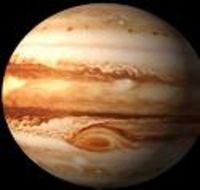 Scientists deduce that Jupiter's Great Red Spot has shrunk over the past dozen years
Scientists deduce that Jupiter's Great Red Spot has shrunk over the past dozen years
The American Institute of Physics Bulletin of Research News
Feb. 26, 2008 -- The hurricanes that visit the Gulf and Caribbean in September and even the huge jetstream that dominates winter weather in North America are small compared to Jupiter's Great Red Spot. The Spot is a lozenge-shaped storm and is about two Earth-widths across. Like meteorologists who study earthly hurricanes to better understand the behavior of these violent storms, planetary astronomers try to record detailed images of the Spot to better to understand weather on Jupiter -- a planet (with no visible solid surface at all) that is nothing but weather.
Detailed images are hard to come by since the Great Red Spot is always on the go. First, the planet as a whole is rotating. Then the Spot is moving along its horizontal band, a cloud band stretching all the way around the planet. Then this band is moving relative to some of the other parallel bands at other latitudes. Furthermore, the Spot is revolving counterclockwise about once every six Earth-days. Finally, the camera taking pictures, mounted on flyby missions like the Galileo or Cassini spacecraft, are themselves shooting through space at thousands of miles per hour.
Xylar Asay-Davis, a scientist at the University of California at Berkeley, says that a further complication in sizing up the Spot is the fact that various clouds not actually part of the Spot are hovering nearby. Some of these clouds nip off parts of the Spot or are, in their turn, taken up into the Spot. The only true way to measure the true extent and motion of the Great Red Spot, he says, is to measure wind speeds.
For that purpose, Asay-Davis and his colleagues have produced the best ever map of wind speeds on Jupiter, where the gusts are typically at the level of 250 miles per hour, higher than winds we see in hurricanes on Earth. The maps consist of tens of millions of velocity measurements and provide a sharp image of what's happening with the Spot. Indeed, according to Xylar Asay-Davis these maps represent the highest resolution and highest accuracy full-planet map ever produced.
The maps draw on data from Galileo and Cassini and even observations from the Hubble Space Telescope, and are processed with sophisticated software. From all this number crunching, the team of scientists deduce that the Great Red Spot has shrunk over the past dozen years. The Spot has survived for at least 300 years and is in no danger of dissipating, says Asay-Davis. Those nearby clouds, regularly bumping into Spot can subtract or add energy from it.
Asay-Davis reported his findings at a meeting of the American Physical Society fluid dynamics division.

 Scientists deduce that Jupiter's Great Red Spot has shrunk over the past dozen years
Scientists deduce that Jupiter's Great Red Spot has shrunk over the past dozen years








